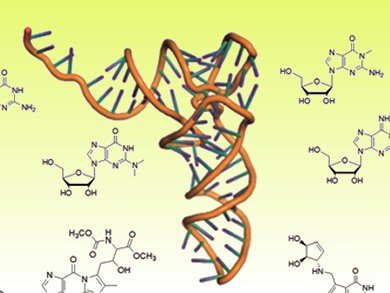DNA, RNA, and tRNA
Our genetic code consists of four “letters” in the form of the nucleobases in our DNA and RNA. Three letters together form a “word” that are translated into an amino acid by tRNA and combined into proteins. Special markings subdivide the gene into active and inactive regions. A third possible level of information has so far received less attention: the chemical modification of tRNA nucleobases. In the journal Angewandte Chemie, Thomas Carell and a team at the University of Munich, Germany, have now demonstrated that tRNA modification profiles can be used for the characterization of species and the differentiation of pathogenic and nonpathogenic bacterial strains.
Species-Specific Modified Bases
There are over 100 different modifications that occur in RNA, the exact informational function of which remains unknown. Some are thought to improve the maintenance of reading frames; others may influence the stability of the RNA or participate in “proofreading”. It was recently discovered that the entire collective of modified tRNA nucleosides is a regulative component of the stress response.
In order to learn more about the function of modified nucleobases, the researchers investigated which modifications occur in what numbers in various species. They examined several gram-positive and gram-negative strains of bacteria, various fungi, and different cell components from pigs.
It turns out that the set of modified bases, as a whole, is largely species-specific. Related species have similar profiles, while unrelated ones are clearly different. Says Carell: “We were able to use this data to compute a detailed family tree of the various species that agreed with results from conventional methods. The entire sets of base modifications of a species clearly developed under the pressure of evolutionary selection.”
Differentiating Between the Harmless and the Dangerous
The researchers compared pairs of pathogenic and nonpathogenic, as well as antibiotic-resistant and non-resistant bacteria. “The bacteria we studied are among the most dangerous clinical pathogens and are responsible for many deaths,” according to Carell. “It was possible to differentiate between the harmless and dangerous species by using the tRNA modification profile.” For the listeria and staphylococci that were analyzed, the pathogenic and resistant species had a significantly higher proportion of some modified bases. “This is an indication that the translation process, that is the translation of the genetic code into proteins, occurs in a significantly different way than in less dangerous strains of these bacteria.”
Image: © Wiley-VCH
- Systems-Based Analysis of Modified tRNA Bases
D. Globisch, D. Pearson, A. Hienzsch, T. Brückl, M. Wagner, I. Thoma, P. Thumbs, V. Reiter, A. C. Kneuttinger, M. Müller, S. A. Sieber, T. Carell,
Angew. Chem. Int. Ed. 2011.
DOI: 10.1002/anie.201103229




